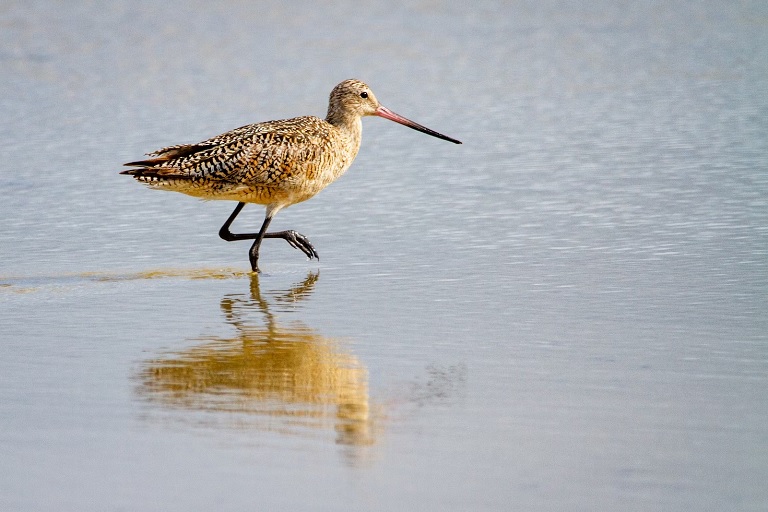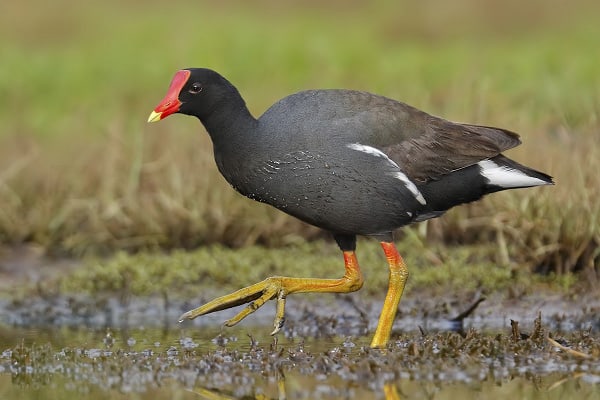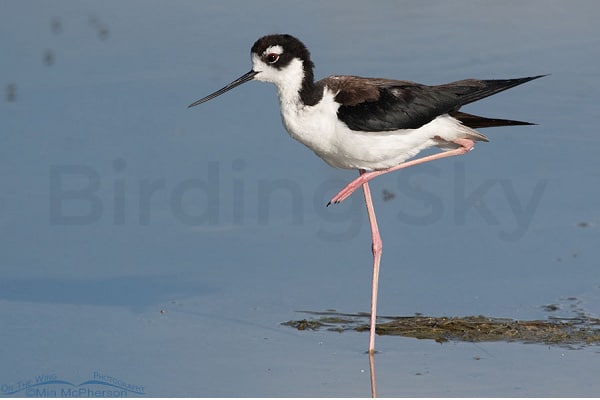Small birds with long necks may not be the most common sight in the avian world, but they certainly capture our attention with their unique and elegant features. In this post, we’ll explore seven fascinating examples of these charming creatures, from hummingbirds to wading birds, and discover what makes them so intriguing.
Here Are 7 Types of Small Birds with Long Necks (Names + ID)
1. Hummingbirds

You might have seen a tiny bird with a long neck and a colorful body near a flower. This bird is called a Hummingbird. It has a long neck and a long bill that helps it drink sweet nectar from the flower. It also has a fast heart and a fast wing that makes it fly like a helicopter. Here are some amazing facts about this bird.
How Small Are They?
Hummingbirds are very small birds. They are only about 3 to 5 inches long, which is about the length of a finger. They weigh about 2 to 20 grams, which is about the weight of a coin. Their wingspan is about 3 to 4 inches, which is about the width of a hand.
How Do They Eat?
Hummingbirds like to eat nectar and insects. They fly to flowers, where they can find nectar. They use their long necks and bills to reach deep into the flower and suck the nectar. They also use their long tongues to lick the nectar. They catch insects for protein and vitamins.
Where Do Hummingbirds Live?
Hummingbirds can be found in the Americas, from Alaska to Tierra del Fuego. They like warm and sunny places where there are a lot of flowers and trees. They live in these places all year round unless it gets too cold or dry. They make their nests in the branches, using spider webs and plant fibers.
What Makes Them Fast?
Hummingbirds have a fast heart and a fast wing. Their heart beats up to 1,200 times per minute, which is about 20 times per second. Their wing beats up to 80 times per second, which is faster than the human eye can see. They can fly forward, backward, sideways, and upside down. They can hover in the air and change direction quickly. They are very good at flying and maneuvering.
2. Spotted Sandpiper

Have you ever seen a small bird with a long neck and a spotted chest near the water? If you have, you might have encountered a Spotted Sandpiper. These birds are not only cute, but also very interesting. Here are some facts about them that you might not know.
How Big Are They?
Spotted Sandpipers are not very big. They are only about 7 to 9 inches long, which is about the size of a banana. They weigh about 1.5 to 2 ounces, which is less than a cup of water. Their wingspan is about 16 to 18 inches, which is about the length of a ruler.
How Does Spotted Sandpiper Behave?
Spotted Sandpipers have a unique way of moving. They bob their tails and stretch out their necks while they walk along the water’s edge. This makes them look like they are dancing or nodding. They do this to scare away predators and to find food. They use their long necks to catch insects and small animals from the shore and the water.
Where Do They Live?
Spotted Sandpipers can be found in both North and South America. They like to live near freshwater habitats, such as lakes, rivers, and ponds. They breed in these places during the summer and then fly to the coastlines during the winter. They are very adaptable and can live in different climates and environments.
What Makes Them Special?
Spotted Sandpipers have a very unusual social system. Unlike most birds, the females are more aggressive and territorial than the males. They fight for the best nesting sites and mate with multiple males. The males take care of the eggs and the chicks, while the females move on to find new mates. This is very rare among birds and shows how different they are from other species.
Visit: Explore 4 Doves in Michigan with Pictures
3. Solitary Sandpiper

You might have seen a small bird with a long neck and a dark back near a wetland or a mudflat. This bird is called a Solitary Sandpiper. It is related to the Spotted Sandpiper, but it has some differences. Here are some things you should know about this bird.
How Small Are They?
Solitary Sandpipers are not very big birds. They are only about 7.5 to 8.5 inches long, which is about the length of a pencil. They weigh about 1.5 to 2.5 ounces, which is less than a slice of bread. Their wingspan is about 15 to 16 inches, which is about the width of a laptop.
How Do They Act?
Solitary Sandpipers like to be alone. They are rarely seen in groups. They live in wooded wetlands, where they can find food and hide from predators. They eat insects and small animals that live in the water. They use their long necks to reach for them without getting wet.
Where Do They Go?
Solitary Sandpipers travel a lot. They breed in North America, where they find old nests of other birds to lay their eggs. They migrate to South America for the winter, where they can find warmer weather and more food. They can fly long distances without stopping.
What Makes Them Different?
Solitary Sandpipers have a surprising secret. Even though they are called solitary, they sometimes help each other raise their young. This is called cooperative breeding. Some adults will join a pair of sandpipers and help them feed and protect their chicks. This is very rare among birds and shows how smart and social they can be.
Related Small Birds With Redhead (ID Guide With Photos)
4. Least Bittern

You might not notice a Least Bittern even if you are near one. These birds are very good at hiding in the marshes and wetlands where they live. They have long necks that help them stay out of sight and catch their food. Here are some amazing facts about these birds.
How Small Are They?
Least Bitterns are very small birds. They are only about 11 to 14 inches long, which is about the length of a ruler. They weigh about 2 to 4 ounces, which is less than a can of soda. Their wingspan is about 16 to 18 inches, which is about the width of a pillow.
How Do They Live?
Least Bitterns are very shy birds. They live in thick reeds and grasses that grow near water. They use their long necks to stretch and look out for fish, frogs, and bugs. They can also bend their necks to blend in with the plants. They are very hard to see and hear.
Where Do They Go?
Least Bitterns can be found in North and Central America. They like warm and humid places where there is plenty of water and vegetation. They breed in these places during the spring and summer and then fly to warmer areas for the winter. They are very adaptable and can live in different habitats.
What Makes Them Special?
Least Bitterns have a very unique sound. They make a low, repeated call that sounds like “coo-coo-coos”. They use this call to communicate with each other and to attract mates. They also use it to warn other birds of danger. This sound is very different from other birds and shows how special they are.
5. Common Gallinule

You might have seen a medium-sized bird with a long neck and a bright red and yellow bill near a marsh or a wetland. This bird is called a Common Gallinule. It is also known as a moorhen. It has a long neck that helps it find food in the water. Here are some cool facts about this bird.
How Big Are They?
Common Gallinules are not very big or small birds. They are about 10 to 15 inches long, which is about the length of a shoe. They weigh about 8 to 14 ounces, which is about the weight of a bottle of water. Their wingspan is about 21 to 26 inches, which is about the width of a door.
How Do They Eat?
Common Gallinules like to eat plants and animals that live in the water. They swim in freshwater marshes and wetlands, where they can find plenty of food. They use their long necks to reach under the water and grab their food. They also use their colorful bills to pick up their food and show off to other birds.
Where Do They Live?
Common Gallinules can be found in the Americas, from the United States to South America. They like warm and wet places where there is a lot of water and vegetation. They make their nests in the reeds and grasses near the water. They stay in these places all year round unless it gets too cold or dry.
What Makes Them Fun?
Common Gallinules have a fun personality. They are very good at swimming and can even walk on lily pads. They are not very graceful on land, but they can run and fly if they need to. They make a loud and varied sound that sounds like “cluck-cluck-cluck”. They use this sound to communicate with each other and to defend their territory.
You May Want to Red: Does Red Peacock Exist? Everything You Need To Know
6. Black-necked Stilt

You might have seen a bird with a long neck and a black-and-white body near a wetland or a coast. This bird is called a Black-necked Stilt. It has long legs and a long neck that helps it find food in the water. It also has a beautiful look that makes it easy to spot. Here are some interesting facts about this bird.
How Big Are They?
Black-necked Stilts are not very big or small birds. They are about 14 to 16 inches long, which is about the length of a bottle of wine. They weigh about 4.5 to 7 ounces, which is about the weight of a bar of soap. Their wingspan is about 24 to 28 inches, which is about the width of a towel.
How Do They Eat?
Black-necked Stilts like to eat small animals that live in the water. They walk in shallow waters, where they can find insects and invertebrates. They use their long necks to reach down and grab their food. They also use their sharp bills to pierce their prey and swallow it whole.
Where Do They Live?
These small Black-necked Stilts birds with long necks can be found in North and South America. They like wet and warm places where there is a lot of water and vegetation. They live in coastal and inland wetlands, such as salt marshes, lagoons, and ponds. They stay in these places all year round unless it gets too cold or dry.
What Makes Them Beautiful?
Black-necked Stilts have a stunning look. They have a black head, neck, back, and tail, and a white chest, belly, and legs. They also have a red and black bill and pink legs. They look like they are wearing a tuxedo and a mask. They are very easy to see and admire.
7. Wilson’s Snipe

You might not notice a Wilson’s Snipe even if you are near one. These birds are very good at hiding in the grass and mud where they live. They have long bills and necks that help them find food in the ground. They also have a special talent that makes them sound like a jet plane. Here are some amazing facts about these birds.
How Small Are They?
Wilson’s Snipe are very small birds. They are only about 8.5 to 11 inches long, which is about the length of a carrot. They weigh about 2.5 to 5 ounces, which is about the weight of a lemon. Their wingspan is about 16 to 18 inches, which is about the width of a pizza.
How Do They Eat?
Wilson’s Snipe like to eat worms and other animals that live in the soil. They walk in wet meadows and marshes, where they can find plenty of food. They use their long bills and necks to dig deep into the mud and grab their food. They also use their sensitive bills to feel their food and pull it out.
Where Do They Live?
Wilson’s Snipe can be found in North and Central America. They like cool and moist places where there is a lot of grass and water. They live in these places all year round unless it gets too cold or dry. They make their nests in the ground, hidden by the vegetation.
What Makes Them Special?
Wilson’s Snipe have a hidden talent. They can make a loud and fast sound that sounds like “winnowing”. They use this sound to attract mates and to show off their skills. They make this sound by flying high in the air and then diving down quickly. The air rushes through their tail feathers and makes the sound. This sound is very different from other birds and shows how special they are.
See Also: Ducks in Michigan
Frequently Asked Question
Q1: Which birds have a long neck?
Birds with long necks can vary widely in species and habitat, but some examples of birds with long necks include swans, herons, egrets, flamingos, cranes, and certain types of ducks and geese. Additionally, smaller birds like hummingbirds and sandpipers also have relatively long necks compared to their body size.
Q2: What is a small water bird with a long neck?
One example of a small water bird with a long neck is the Spotted Sandpiper. These shorebirds are relatively small in size and are often seen foraging along the water’s edge with their distinctive bobbing motion and long necks extended as they search for food.
Q3: Which bird has a long neck and long legs?
Birds that typically have long necks and long legs are waders or shorebirds. Some examples include the Black-necked Stilt, Great Blue Heron, and Greater Flamingo. These birds have adapted to wade in shallow waters, and their long legs and necks help them reach for food in aquatic environments.
Q4: What is a GREY bird with a long neck?
A grey bird with a long neck could be a description of several species, but one common example is the Grey Heron. Grey Herons are large wading birds with grey plumage and long necks. They are often seen near water sources, patiently waiting for fish or other prey.
Q5: What is a white bird with a long neck?
A white bird with a long neck could refer to various species, but one classic example is the Great Egret. Great Egrets are large, elegant wading birds with all-white plumage and long, graceful necks. They are often found in wetlands and marshy areas.
Q6: What bird has a long neck and runs fast?
One bird with a long neck that is known for its impressive speed on land is the Ostrich. Ostriches are the largest and heaviest of all living birds, and they have long necks that allow them to reach vegetation and spot predators. They are also incredibly fast runners, capable of reaching speeds of up to 45 miles per hour (72 kilometers per hour).
